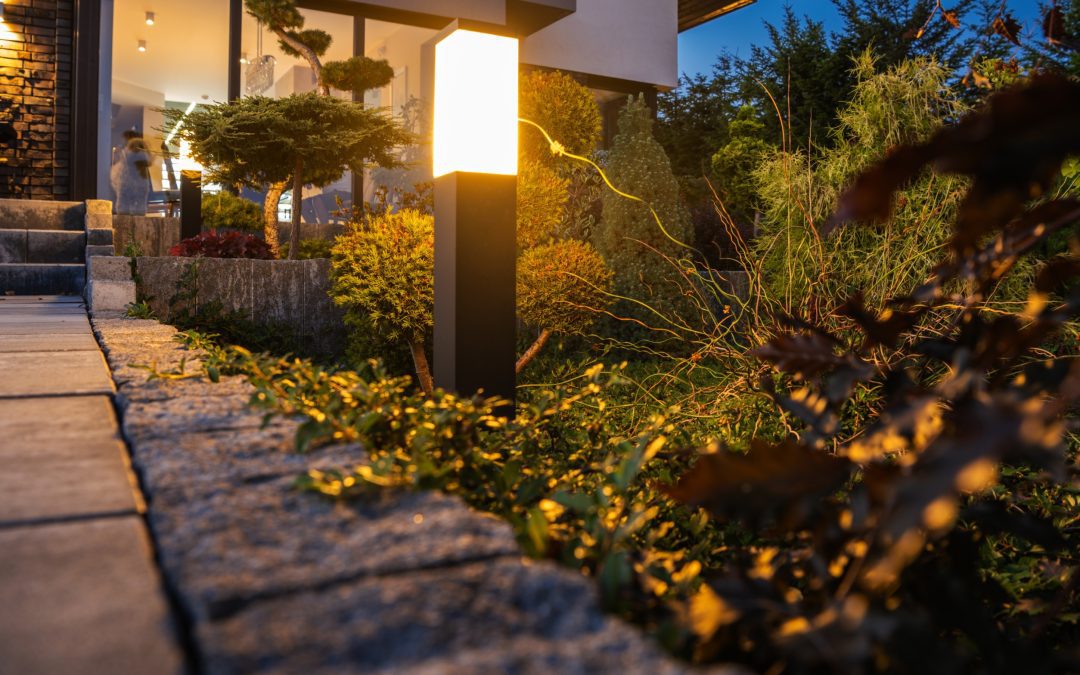Color temperature refers to the warmth or coolness of the light emitted by a bulb, and it is measured in Kelvin (K). Understanding how different color temperatures affect your landscape can help you create the desired atmosphere and improve the overall beauty of your outdoor environment.
Here’s an in-depth look at each key point to consider when selecting the ideal color temperature for your landscape lights.
Understanding Color Temperature
You can categorize color temperatures into warm, neutral, and cool tones. Warm light (2000–3000K) emits a cozy, yellowish glow resembling candlelight, ideal for creating a relaxing and inviting atmosphere.
Cool light (4000–5000K) has a bluish-white tone, providing clear visibility and a modern aesthetic. Neutral light (3000–4000K) falls between warm and cool, offering a balanced illumination suitable for various outdoor settings.
Assessing Your Landscape’s Design and Features
Start by assessing your landscape’s design elements and features. Consider your home’s architectural style, the types of plants and hardscapes, and any specific focal points you want to highlight. Each element may benefit from a different color temperature to achieve the desired effect.
For instance, warm temperatures are ideal for showcasing intricate details. Conversely, cool temperatures are effective for creating contrast and drama.
Highlighting Texture and Detail
Choosing the right color temperature significantly impacts how you perceive textures and details in your landscape. Warm light enhances warm-colored materials like wood and stone, bringing out natural tones and textures. It creates a welcoming and intimate atmosphere, perfect for outdoor seating areas, garden paths, and patios where you desire a cozy ambiance.
In contrast, cooler color temperatures can accentuate cooler-colored materials and provide a sharper contrast between light and shadow. This can be particularly effective in highlighting water elements and modern landscape designs. The cooler light temperature adds a contemporary feel and helps create a more open and spacious appearance in outdoor spaces.
Creating Drama with Cool Tones
Cool color temperatures are effective for creating drama and depth in your landscape. They provide a clear, bright light that improves visibility and creates a modern aesthetic. This makes them ideal for highlighting architectural elements such as columns, facades, and statues and illuminating driveways.
By strategically placing cool-toned lights in key areas of your landscape, you can create visual interest and draw attention to focal points. The crisp, white light adds elegance and sophistication, making it a popular choice for contemporary outdoor designs.
Balancing Light Fixtures with Surroundings
Make sure the color temperature of your landscape lights complements the surrounding environment and existing outdoor lighting fixtures. Consistency in color temperature creates a cohesive look and prevents mismatched aesthetics that could detract from your landscape’s overall appeal.
For example, if you have outdoor lighting with warm color temperatures, such as decorative lanterns or wall sconces, choose landscape lights with similar warmth to maintain visual harmony. Alternatively, you can create deliberate contrasts by mixing warm and cool color temperatures strategically to highlight different areas and features within your landscape.
Harmonizing with Natural Moonlight
Consider how your chosen color temperature will blend with natural moonlight to create a harmonious nighttime atmosphere. Warm color temperatures mimic the soft, gentle glow of moonlight, creating a seamless transition between natural and artificial lighting sources. This can improve the overall ambiance of your outdoor space and create a serene environment for evening relaxation and enjoyment.
In contrast, cooler color temperatures provide a bright, clear light that complements moonlight’s cool, silvery tones. This combination can create a more vibrant and dynamic nighttime landscape.
Testing before Committing
Before making a final decision, test different color temperatures in your landscape to see how they interact with your surroundings during different times of the day and night. Many lighting suppliers offer sample kits or demonstration areas where you can observe the effects of warm, neutral, and cool color temperatures firsthand.
Set up temporary lighting fixtures in key landscape areas and observe how each color temperature affects mood, visibility, and overall ambiance. Pay attention to how different lighting tones enhance or subdue textures, colors, and architectural features, and choose the option that best complements your landscape’s design and aesthetic goals.
Energy Efficiency and Longevity
Evaluate the energy efficiency and longevity of LED bulbs at various color temperatures. LED lights consume less energy than traditional bulbs and have a longer lifespan, making them a sustainable choice for landscape lighting solutions.
Consider the wattage and lumens of LED bulbs to make sure they provide adequate brightness and coverage while minimizing energy consumption and maintenance costs.
Seeking Professional Advice
If you’re unsure about choosing the right color temperature for your landscape lights, consider consulting with a professional lighting designer or landscape architect. They can offer expert guidance based on your specific needs, ensuring that your lighting design increases your outdoor space’s functionality and beauty.
Whether aiming for a cozy retreat or a modern showcase, the right color temperature can transform your landscape into a stunning nighttime sanctuary. Our professionals at Sarasota Landscaping can offer you the best assistance for your landscape lighting needs. Contact us today to learn more!

